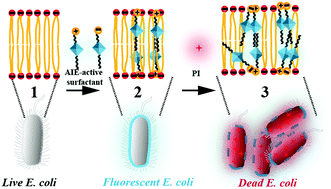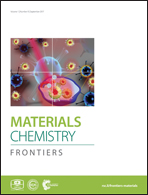Lighting up the interactions between bacteria and surfactants with aggregation-induced emission characteristics†
Abstract
We report a method for imaging and tracking the interactions between bacteria and surfactants by using two ionic surfactants with aggregation-induced emission (AIE) characteristics. The fluorescence of the cationic AIE-active surfactant, tetraphenylethene-dodecyltrimethylammonium bromide (TPE-DTAB), can be turned on in the presence of bacteria, while the anionic AIE-active surfactant, tetraphenylethene-sodium dodecyl sulfonate (TPE-SDS), hardly interacts with bacteria due to electrostatic repulsion. Moreover, TPE-DTAB is applied for imaging its interaction with bacteria. In the fluorescence images, TPE-DTAB with one positively-charged ammonium is firstly attracted to the anionic surfaces of bacteria through electrostatic attraction, and then its long alkyl chain could insert into the bacterial membrane. The disturbing effect of membrane permeability leads to the death of bacteria. Unexpectedly, TPE-DTAB containing a certain amount of TPE-SDS can attain a higher efficiency of killing bacteria. The negative charge of the bacterial membrane has decreased due to the neutralization of TPE-DTAB, making TPE-SDS easier to get close to and react with membrane proteins. The synergistic effect on membrane damage leads to the higher antibacterial efficiency and massive agglomerations of dead bacteria.

- This article is part of the themed collection: Aggregation-Induced Emission


 Please wait while we load your content...
Please wait while we load your content...